Discover Local Real Crystals: A Comprehensive Guide
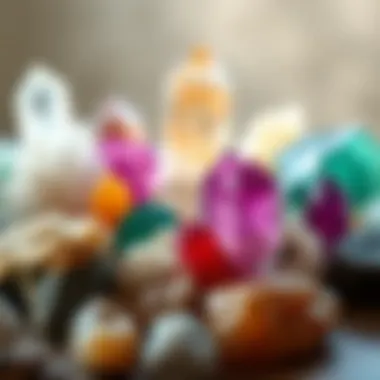
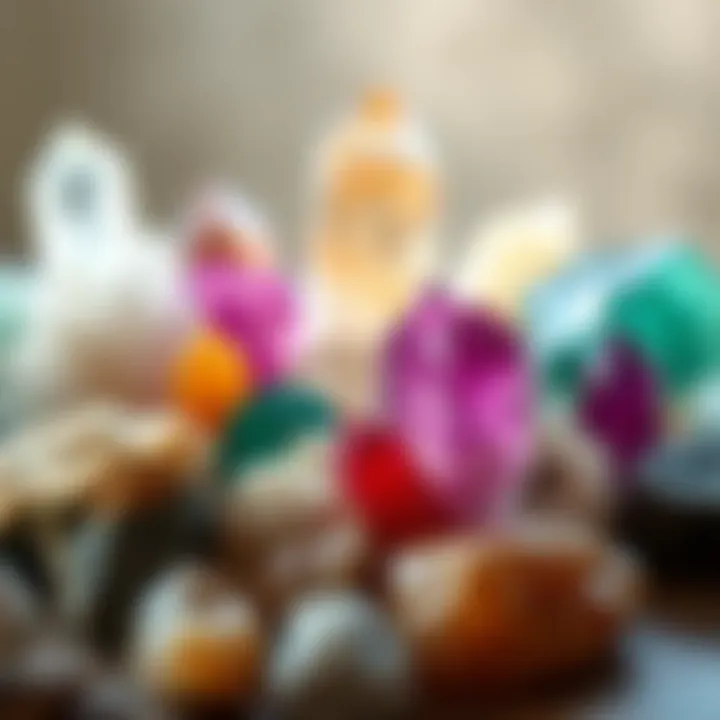
Intro
Crystals are more than just pretty rocks; they are a connection to the earth’s history and a testament to the natural processes that shape our world. Locating real crystals in your local area can be a thrilling experience, a way to dig deeper into geology and appreciate art in its raw form. This guide will walk you through the fascinating world of local crystals—how to find them, appreciate them, and understand their significance. Whether you’re a collector or simply curious about the shimmering pieces of nature, this article aims to kindle a passion for crystal exploration.
History and Origins
Overview of Collectibles, Rocks, and Fossils
The practice of collecting rocks and crystals dates back thousands of years. From early civilizations that treasured stones for their supposed mystical properties to modern enthusiasts drawn by their beauty, each crystal holds a story. Historically, different cultures have imbued crystals with a variety of meanings. For instance, ancient Egyptians often used lapis lazuli for jewelry, believing it brought protection and fortune.
In more recent history, the Victorian era saw a surge in the popularity of rock polishing and collecting, establishing clubs that celebrated these natural wonders. Today, the rise of internet communities has only fueled the interest in learning, sharing, and connecting over crystals.
Historical Significance and Cultural Impact
Crystals play a significant role in the cultural narratives of many societies. Many stones were used in rituals or as talismans. For instance, in Native American cultures, certain crystals are regarded as sacred and used in ceremonies to promote healing and spiritual growth. In the realm of folklore, quartz has been considered a source of energy and clarity, often referred to as the "master healer."
Crystals are not just valuable in a cultural or historical context, but they also provide insight into the earth's formative processes. The very existence of crystals tells the tale of geological changes over millions of years, from cooling magma to sediment compaction, inviting collectors to become part of that long narrative.
"The beauty of a crystal is not merely in its aesthetic appeal but in its ability to evoke the layers of time and transformation present in our world."
Identification and Classification
Guide to Identifying Rocks and Fossils
Identifying crystals requires a keen eye and a bit of education. Start by familiarizing yourself with basic terminology and features. Common aspects to observe include:
- Color: Many stones can be classified by their predominant hue.
- Hardness: Use the Mohs scale to determine how soft or hard a mineral is.
- Luster: Notice whether a crystal has a shiny (metallic), glassy (vitreous), or dull appearance.
- Streak: Scratch the stone on unglazed porcelain to reveal the color of its powder.
Be aware of local regulations regarding collecting. Some areas may have protected sites where taking crystals or rocks is illegal.
Common Types and Variations
- Quartz: One of the most abundant minerals, found in various forms including amethyst, rose quartz, and citrine.
- Feldspar: Another widespread mineral that can often be identified by its flat surfaces.
- Calcite: Characterized by its rhombohedral shape and can appear in colors ranging from white to yellow.
Each type of crystal or rock can tell a different story—some may have formed under high pressure deep within the Earth, while others have been molded by the gentle kisses of wind and water.
As you step into this world of natural wonders, your journey into understanding crystals will open doors to a deeper connection with geology and nature itself.
Understanding Crystals
Understanding crystals is precious for anyone venturing into the fascinating world of geology or simply wanting to grasp more about natural wonders nearby. This knowledge offers valuable insights, not only into their formation but also into how to identify and appreciate the beauty contained in these geological treasures.
At the core, crystals are more than just pretty stones; they represent a snapshot of our planet’s geological processes, reflecting the environmental conditions from which they originate. This exploration sheds light on how the Earth's elements come together to create unique and stunning formations, suited for both collectors and enthusiasts alike.
Definition of Crystals
Crystals are solid materials where atoms are arranged in a highly ordered structure, forming a repeating pattern. This orderly arrangement happens at the molecular level and can take on various shapes, leading to an incredible diversity in crystal types. For instance, the famed quartz crystal, which can be found in various environments, showcases a simple hexagonal structure that is widely recognized due to its beauty and availability.
While many perceive crystals as simply decorative, they play significant roles in various fields, including electronics, pharmaceuticals, and even the culinary arts. For example, table salt, or sodium chloride, is a common crystal that serves crucial roles beyond flavoring food.
Formation Processes of Crystals
Crystals form through various natural processes, each fascinating in its own right. Understanding these processes can provide deeper insights into where to find crystals and the conditions necessary for their formation. Here are some of the predominant processes:
- Cooling of Magma: When molten rock cools, minerals crystallize as the temperature drops. This method often leads to the formation of igneous rocks, which may contain gems and stones, such as diamonds and obsidian.
- Evaporation: As water evaporates, the minerals dissolved in it can crystallize. This method is particularly common in salt flats, where sodium chloride forms crystals when ocean water evaporates.
- Metamorphism: Under immense temperature and pressure, existing minerals can rearrange their atomic structures, resulting in new crystalline forms. This can be seen in metamorphic rocks that yield beautiful crystals like garnet and jade.
Understanding these fundamental processes arms crystal enthusiasts with the knowledge to seek out potential locations for collection, adding to the thrill of exploration.
Types of Crystals
Crystals can be categorized generally into three types: mineral, organic, and synthetic. Each type brings its unique qualities and appeal to the table.
Mineral Crystals
Mineral crystals are perhaps the most commonly discussed and sought after. These naturally occurring formations exhibit various colors, textures, and sizes, resulting from the minerals' specific atomic arrangements and environmental conditions at the time of formation. One key characteristic of mineral crystals is their crystalline lattice structure, which defines their geometric shape.
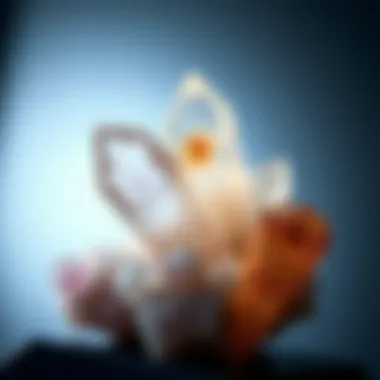
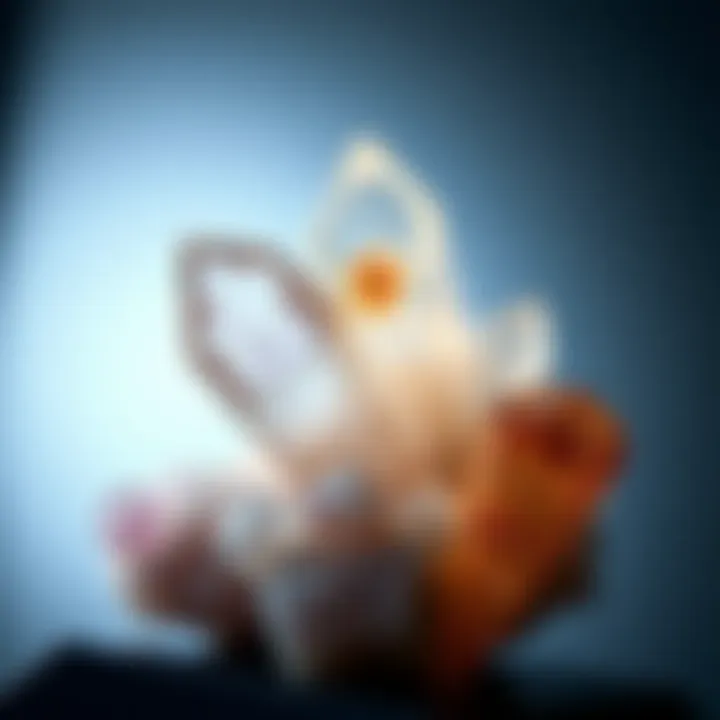
Mineral crystals are a popular choice for collectors due to their vast diversity. From the mesmerizing beauty of amethyst to the icy shimmer of calcite, they can serve both aesthetic and educational purposes. Their unique features often signify geological conditions, allowing collectors to connect with the Earth’s history. However, as appealing as they are, some mineral crystals can be fragile, needing careful handling.
Organic Crystals
Unlike their mineral counterparts, organic crystals come from biological processes. They can include substances derived from organisms, such as the striking mineral called aragonite, which forms in the shells of marine animals.
What sets organic crystals apart is their connection to life processes, making them not only visually appealing but also ecologically significant. While they might not be as widely known or collected compared to mineral crystals, they provide a glimpse into the intricate interplay between living organisms and their environment. The challenge with organic crystals lies in their potential rarity and the delicate nature of their formation.
Synthetic Crystals
Synthetic crystals are lab-created materials that mimic the properties of natural crystals. These include precious stones like cubic zirconia, which resemble diamonds, or synthetic emeralds developed to satisfy demand without depleting natural resources. The primary aspect of synthetic crystals is that they are crafted intentionally, allowing for a higher degree of control over their properties and appearance.
Their benefits lie in their availability and often lower cost compared to natural counterparts. However, some collectors may prefer natural crystals for their unique formations and history. Synthetic variations raise interesting discussions regarding authenticity, values, and the future of crystal collecting.
Where to Find Real Crystals Near You
Finding real crystals nearby can be an enriching experience, blending adventure with the thrill of discovery. Whether you’re a seasoned collector or just starting out, there are several hidden gems (literally!) waiting to be found in local parks, rock collecting sites, and geological formations. Knowing where to look increases your chances of finding unique specimens that can be a beautiful addition to your collection or an interesting subject of study.
Local Parks and Nature Reserves
Local parks and nature reserves often serve as the first step for many amateur collectors. These locations are typically well-preserved, and their natural beauty can enhance the experience of crystal hunting. You might be surprised at the variety of minerals and crystals tucked away in these public spaces. For example, quartz and agate can often be found lying among the rocks.
Visiting these parks also allows you to connect with nature, offering not just a chance to collect but also to learn about local ecosystems and geology.
- Regulations: Always check the rules regarding collection in these areas. Not all parks allow the removal of natural objects.
- Community Interaction: Some parks host workshops and events related to geology, making them great places to meet fellow enthusiasts.
Rock Collecting Sites
Designated rock collecting sites are a collector's paradise. These venues are usually more abundant, sometimes operating under permits to maintain responsible practices. Here you can find a plethora of minerals that have already been identified as safe for collection.
Rock collecting sites often feature:
- Guiding Information: Many will have signs up explaining the different types of rocks and site-specific regulations. This kind of information is invaluable for identifying what you find.
- Facilitated Exploration: Some sites will offer guided tours, showing you the best spots and teaching you about rock types and collection methods.
Geological Features to Explore
Caves
Caves present an exciting and otherworldly environment for huntin crystals. They often harbor unique geological formations, shaped over millennia. The darkness and dampness of caves can lead to the formation of different types of crystals, such as stalactites and stalagmites, enhancing the diversity of what you can find.
However, exploring caves requires caution:
- Lighting and Safety: Always take proper lighting and be aware of your surroundings, as caves can be labyrinthine and treacherous.
- Potential Acquisitions: Collecting may be restricted in certain caves to protect delicate ecosystems, so it's critical to research beforehand.
Quarries
Quarries can be a treasure trove of minerals. They are man-made sites where rocks have been blasted away, revealing layers that often contain crystals in their natural state. Quarries are particularly good for finding larger specimens that may not be present in other environments.
The key advantages of quarries include:
- Rich Diversity: Different rock strata can yield a wide array of crystal types, including rare finds.
- Accessibility: Many quarries are open to the public, though some may require permission or a fee to collect.
Riverbeds
Last but not least, exploring riverbeds can lead to the discovery of new crystals. Rivers are natural agents of erosion and transportation for minerals, bringing them from high lands down to the plains. As a result, riverbeds can often yield beautiful tumbled stones and agates.
- Continuous Flow: The constant flow of water means that riverbeds change over time, and new rocks can come to the surface after storms or seasonal changes.
- Low-Impact Exploration: Collecting in these areas usually has less impact on the environment compared to other locations, making it a more sustainable choice.
Returning home with a new crystal collection is always rewarding. Knowing where to look makes it much easier, providing not only finds but also stories. Happy hunting!
Identifying Real Crystals
Within the realm of crystal collecting, having the ability to differentiate genuine crystals from mere glass or synthetic imitations serves as a foundational skill. Not only does it enhance the collector's journey, but it also allows for a more profound appreciation of nature's intricacies. Crystals can be captivating, often showcasing stunning colors, intricate shapes, and unique characteristics. By sharpening your identification skills, you won't just acquire beautiful pieces but also enrich your understanding of geology and mineralogy. Additionally, collecting authentic crystals reinforces ethical practices in the crystal community, ensuring that enthusiasts respect natural formations and avoid exploiting local resources. Whether you're a seasoned collector or a novice just dipping your toes into the world of minerals, understanding how to identify real crystals can elevate your collecting experience.
Visual Inspection Techniques


When setting out to identify genuine crystals, visual inspection stands as your first line of defense. It's crucial to look closely at a crystal's surface and overall appearance. Here are some practical techniques:
- Light Reflection: Observe how light interacts with the crystal. Genuine crystals often reflect light differently than glass due to their unique internal structures.
- Scratches and Color Depth: Run your fingernail across the surface gently; true crystals are more resistant to scratches. Also, notice the depth of color; genuine crystals often display richer, multi-dimensional hues.
- Geometric Shapes: Take note of the crystal's shape. Understanding the common geometrical patterns of various crystal types can aid in identification.
Incorporating these techniques can significantly improve your chances of identifying real crystals effectively.
Common Characteristics of Genuine Crystals
Clarity
Clarity is a key aspect when evaluating crystals. This characteristic refers to the level at which light can pass through the material. A more transparent crystal allows light to shine through beautifully, showcasing its structure and color. On the flip side, a crystal with numerous inclusions or a cloudy appearance might indicate lower quality or authenticity challenges. While some collectors may appreciate unique inclusions as part of a crystal's charm, understanding clarity helps in discerning the value of a specimen. A crystal's clarity can determine its appeal, especially among collectors who prize aesthetic qualities.
Color Variations
Color variations in genuine crystals can be both enchanting and informative. Each mineral's color can signify its chemical composition and characteristics. For instance, a deep green color in emerald indicates high chrome content, while amethyst presents a range of purples that can indicate natural beam variations in composition. Collectors should note that natural color variations can enhance a crystal's value, making it more sought after. However, some stones can undergo artificial coloring, making it essential to learn which hues are naturally occurring versus those produced in a lab. This knowledge will ultimately guide collectors toward higher quality specimens.
Surface Texture
The surface texture of crystals can reveal a treasure trove of information about their authenticity. Natural crystals often exhibit textures ranging from smooth to rough, with unique features such as striations or ridges. Indicators such as these can help clearly separate genuine specimens from synthetic counterparts. For example, quartz as a natural crystal can have a slightly rough texture due to its formation process, while glass imitations are often overly smooth and shiny. Understanding how surface texture varies among different crystal types not only assists in identification but also adds richness to the collecting experience; appreciating these subtleties ultimately contributes to a collector's growth and knowledge.
"In the world of crystals, a collector’s keen eye can uncover treasures, yet it is understanding that transforms simple interest into deep appreciation."
By focusing on clarity, color variations, and surface textures, collectors can refine their skills in identifying real crystals. This knowledge not only enhances the collecting experience but also fosters a deeper respect for the natural beauty that these minerals offer.
What to Do After Finding Crystals
Discovering real crystals in your local environment can be like striking gold, not only because of their natural beauty but also due to the depth of care needed afterward. This journey, from unearthing to maintenance, is just as important as the thrill of finding them. Knowing the steps to take after finding crystals ensures you preserve their integrity and maximize their value. In this section, we will touch upon essential practices for cleaning, storing, and displaying your treasures.
Initial Cleaning and Care
Once you've stumbled upon a crystal, the first impulse might be to admire it in its natural state and show it off. Yet, before taking photos or handling it too much, there’s a pressing need for cleaning. Many crystals come coated in dirt or other minerals that could mask their actual beauty. Cleaning doesn’t just enhance appearance; it also protects the crystal from further degradation.
- Gentle Cleaning: Use a soft brush, like a toothbrush, to remove debris without scratching the surface. For stubborn dirt, a little warm water with some mild soap can do wonders, but avoid harsh chemicals.
- Drying Properly: After washing, it’s critical to dry the crystal thoroughly. Leaving it damp can lead to discoloration or damage over time.
- Store Safely for Processing: If you're not displaying the crystal right away, make sure it’s secured in a cushioned box or a container where it won’t bump around.
By taking these initial steps, you help ensure the longevity of your newfound gem, helping it maintain its shine for years to come.
Storing Crystals
Storing your crystals with care can make a big difference in their longevity and overall condition. Positioning them correctly can avoid scratches and breakage. Here are some key considerations when it comes to proper storage:
- Individual Cushioning: Wrap each crystal in a soft cloth or place them in small padded boxes to avoid collision. A few old socks can also do the trick; they're soft and already at home in drawers.
- Temperature Control: Store them in a place where temperature remains stable. Extreme heat or cold can negatively affect some types of crystals, causing fractures or fading in color.
- Minimal Sunlight: Keeping crystals out of direct sunlight helps eliminate the risk of color leaching. For example, amethyst can fade over time if continually exposed to bright light.
Organizing your collection thoughtfully can turn storage into a mini exhibition, enhancing both care and appreciation for each piece.
Displaying Crystals
Showcasing your crystals is where personal style can shine. It’s one thing to have them tucked away in a drawer; it’s another feeling to have them radiating on a shelf or table. Proper display not only accentuates their beauty but also allows you to share your love of geology with others.
Decorative Arrangements
Creating beautiful decorative arrangements can transform a collection into an art piece. Place the crystals in a glass dome, on wooden stands, or within terrariums. This practice emphasizes several key characteristics:
- Aesthetic Engagement: The arrangement not only beautifies your space but sparks conversations and invites curiosity from guests.
- Visibility: Well-arranged crystals are easier to enjoy and appreciate, allowing their unique colors and shapes to contribute to your home’s ambiance.
However, it’s worthwhile to remember that arrangements should also consider the integrity of the crystals. Avoid overcrowding to prevent undue scratches or pressure that might harm fragile specimens.
Educational Purposes
Displaying crystals for educational purposes can be particularly impactful, especially for children or those new to crystal collecting. You can highlight the geological significance of each specimen alongside its beauty. Key elements include:
- Informative Labels: Use small cards with details on each crystal—its name, origin, and unique properties. This aids both in education and ongoing curiosity.
- Interactive Displays: Set up displays that allow others to engage with the crystals, perhaps through touch or observational challenges like identifying specific characteristics.
This combination of education and beauty not only honors the crystals but also cultivates a deeper understanding and appreciation of the natural world.
Overall, managing crystals after finding them involves a thoughtful process. Careful handling, proper storage, and clever display can elevate your crystal collection. Not to mention, every touchpoint from cleaning to displaying is a chance to deepen your connection with nature's artistry.
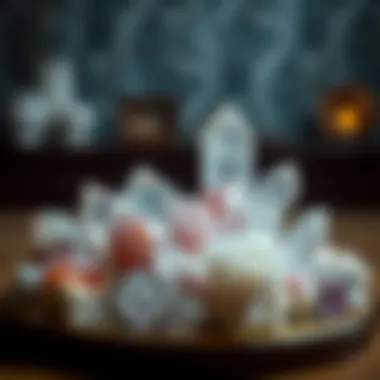

The Benefits of Collecting Crystals
Collecting crystals goes beyond mere hobby or decorative interest; it taps into a deeper connection with nature and the earth's history. Crystals have captivated individuals for centuries, serving not only as eye-catching pieces but also as conduits for exploration and personal discovery. This section delves into the multifaceted benefits of collecting crystals, highlighting their aesthetic and therapeutic values.
Aesthetic Value
One cannot overlook the stunning beauty of real crystals. The visual appeal is significant, with various colors, shapes, and sizes available from different geological settings. Each crystal presents a unique aesthetic that can enhance the environment around it. Imagine a piece of amethyst with its rich purple hue or a clear quartz crystal with its pristine clarity, both can easily transform the ambiance of a living space.
- Natural Art: Unlike manufactured decor, crystals are nature’s artworks. Each formation tells a story, making them conversation starters in homes or offices.
- Personalized Decor: Crystals come in a plethora of forms—from rough specimens to polished gems—allowing collectors to create personalized arrangements that reflect their style.
- Symbolic Significance: Many collectors appreciate the symbolism tied to each type of crystal, whether it be healing properties or associated meanings, adding a personal layer to their collection.
The intrinsic beauty of crystals has led many to incorporate them into their daily lives—not just as decorative elements but as a reflection of their personal journeys and beliefs.
Therapeutic Benefits
In the realm of holistic wellness, crystals are thought to possess various beneficial properties that can promote emotional and physical well-being. Many individuals believe that certain crystals can aid in healing and provide a sense of balance in life. While scientific support is often a topic of debate, the perceived therapeutic benefits are immense within the community of collectors and enthusiasts.
- Emotional Healing: Crystals like rose quartz are believed to foster love and compassion, helping individuals navigate emotional distress and promoting positive relationships.
- Stress Relief: Collectors often use specific crystals, such as amethyst, for their calming effects. Keeping these crystals nearby can serve as a sensory reminder for tranquility in stressful environments.
- Mindfulness Practices: Incorporating crystals into meditation or yoga practices can deepen focus and intent, offering clarity and grounding that many find rewarding.
The benefits of collecting crystals, while subjective, offer a unique blend of aesthetic pleasure and potential therapeutic advantages. This duality not only cultivates a passion for crystal collecting but also fosters a deeper appreciation for the earth’s remarkable formations.
Advanced Topics in Crystal Collecting
Exploring the realm of crystal collecting transcends beyond mere admiration for shiny stones. It delves into a world where appreciation meets responsibility, valuation intersects with passion, and connections to suitable communities flourish. Understanding advanced topics in this hobby can transform how collectors perceive their specimens, augmenting the experience tenfold.
Valuing Your Collection
Valuation is not simply about assigning a price tag to your precious crystals; it involves a nuanced interplay of factors that inform their worth. Factors such as rarity, size, and quality come into play, but the story behind each specimen can elevate its value significantly. For instance, crystals originating from significant geological events often carry stories that resonate with historical importance.
Moreover, knowledge of market trends can shed light on the financial landscape of crystal collecting. Just like any asset, demands shift, and knowing when to hold onto or let go of a crystal can impact your collection's worth. Make sure to keep abreast of auctions, online marketplaces, and local shows where crystal values may fluctuate.
- Rarity: Unique samples, such as those found only in specific locations, often command higher prices.
- Quality: Assessing clarity, color intensity, and overall condition can massively influence a piece's value.
- Historical Significance: Crystals that are tied to memorable geological events or come from well-known mines typically have added worth.
Ethical Guidelines for Collecting
Crystal hunting shouldn't come at the expense of our natural world. Being a responsible collector means adhering to ethical practices that preserve both the environment and our hobby's reputation. Engaging in reckless collecting can harm ecosystems, disrupt wildlife, or even lead to legal repercussions.
Here are a few guiding principles:
- Leave No Trace: When collecting, take only what you need and ensure that the site remains undisturbed for future enthusiasts.
- Respect Regulations: Always be informed about local laws regarding collection; some areas are off-limits or require permits.
- Support Local Community Efforts: Contributing to conservation efforts or engaging in restoration projects can promote sustainability in your pursuit of crystals.
By upholding these principles, every collector can contribute to a thriving community, fostering both a sense of responsibility and a positive legacy for future hobbyists.
Joining Local Collector Communities
One of the most enriching aspects of crystal collecting lies in community engagement. Local collector groups not only facilitate learning and networking but also deepen the enjoyment derived from the hobby. Joining such a community can provide camaraderie, mentoring, and access to a wealth of shared knowledge unlike any solitary experience.
Many local organizations host events like field trips, educational talks, and swapping meets, allowing enthusiasts to share tips, trade specimens, and even embark on collective excursions. When seeking these communities, keep an eye on:
- Local Rock and Mineral Clubs: Often welcome newcomers and provide structured environments for learning.
- Online Forums and Social Media Groups: Platforms like Reddit and Facebook have communities dedicated to crystal collectors, often sharing valuable insights and resources.
- Workshops and Shows: Participating in these gatherings can lead to connections with knowledgeable individuals who share your passion.
By feeding off the energy and enthusiasm of like-minded individuals, collectors can not only enhance their understanding of crystals but also create lasting relationships built around shared interests.
"The world of crystals is as diverse as the people who collect them, bringing together individuals with a shared fascination for Earth's treasures. The journey of collecting is enhanced not only by what we gather but also by the relationships we forge along the way."
Engaging more deeply in these advanced topics augments the crystal collecting journey, ensuring it remains not just enriching but also sustainable for generations to come.
Ending
Reflecting on the journey of crystal collecting encapsulates much more than mere material admiration; it's a profound venture into understanding nature's artistry and geological history. As collectors, enthusiasts often recognize that every crystal unearthed holds a story, a fragment of time frozen in mineral form. This journey instructs us about Earth’s evolutionary processes, offering insights that textbooks may gloss over.
Engaging in crystal collecting enhances one’s appreciation for the rich tapestry of our planet’s geology. Whether it’s the smooth sheen of a polished amethyst or the rugged surface of quartz, each piece encourages us to slow down, take a closer look, and wonder about its origins. Connect with local environments; it might surprise you how much beauty resides just beneath your feet.
Benefits of Collecting Crystals
- Developing patience: The thrill of the hunt requires time and attention to detail.
- Fostering community: Connecting with fellow collectors and sharing knowledge enhances the experience.
- Creating personal spaces: Crystals add a touch of nature’s beauty to homes, creating tranquil atmospheres.
Through exploration and collection, individuals not only gather objects but also cultivate an appreciation for the intricate processes that shape our world.
"Every crystal is a window into Earth's past, a testament to the beauty of natural processes, and a reminder for us to observe the wonders around us."
Ultimately, the importance of this journey lies in recognizing the relationships formed, both with nature and with fellow enthusiasts. Crystal collecting isn't just about the specimens; it's about discovering shared passions and connecting with the earth in meaningful ways.



